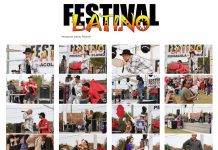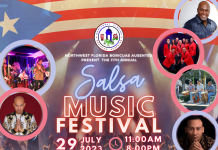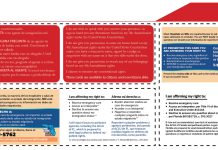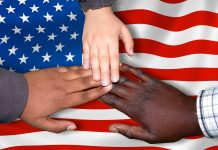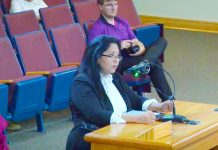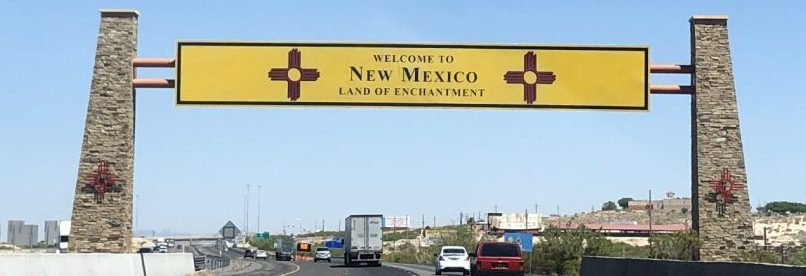
Un viaje a la frontera: Parte 2, La llegada
Por Grace Resendez McCaffery | Diario La Costa Latina | Costa del Golfo de Medios Latinos
La siguiente entrega es de una serie de historias que describen la experiencia que tuve cuando visité un refugio fronterizo en Nuevo México el mayo del 2023.
Mientras la comunidad inmigrante en Florida anticipaba con nerviosismo la nueva ley estatal de inmigración SB1718 que afectaría negativamente sus vidas, hice un viaje por carretera para ayudar a prepararme para el desafío que tendría que ayudar a superar a mi comunidad. Mi viaje de 1300 millas hacia el oeste por la I-10 terminó cuando llegué al refugio fronterizo al que me invitaron en Las Cruces, NM. Me detuve en la puerta de seguridad cuando Chuy, mi amigo de la infancia, se acercó a la cerca de alambre y dijo: “Ella está con nosotros.”
Aunque no lo reconocí porque no nos habíamos visto en más de 30 años, la voz de Chuy me resultó inmediatamente familiar y reconfortante. El guardia abrió la puerta cuando Chuy señaló un espacio de estacionamiento disponible en el estacionamiento que también estaba ocupado por dos grandes carpas de vinilo blanco. Dentro de las tiendas había filas de sillas plegables de metal.
Después de estacionar mi auto, Chuy me acompañó más allá de las carpas y hasta la entrada del edificio donde estaba esperando Ben, el director de viajes de Border Servant Corp. El saludo de Ben fue tan cálido como el de Chuy, como si también fuéramos viejos amigos. Ben me presenta a un par de miembros más del personal, latinas bilingües a las que se hace referencia como expertas en ayudar a los inmigrantes a continuar su viaje aquí en los Estados Unidos. Estas mujeres brindan toda la información que los migrantes necesitan desde el momento en que llegan hasta el momento de que salen de las instalaciones, un antiguo Centro de Reserva del Ejército de EE. UU. que se asemeja a una pequeña escuela.
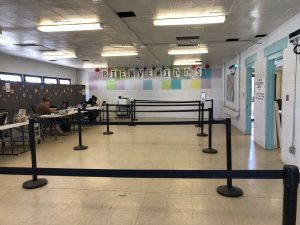 Una vez que la Patrulla Fronteriza entrega un autobús lleno de migrantes al centro, bajan del autobús junto a las carpas blancas donde les dan una botella de agua, una máscara facial opcional y una bolsa plástica para llevar las pocas pertenencias que les quedan. Una vez sentados dentro de las tiendas, los migrantes reciben una bienvenida verbal y una breve orientación en las tiendas antes de que se les indique que entren al edificio. Su primera parada es una gran sala donde los migrantes reciben asistencia personalizada para hacer los arreglos de viaje nacionales. Un cartel colgado en la pared que no se puede perder dice “BIENVENIDOS” en letras grandes.
Una vez que la Patrulla Fronteriza entrega un autobús lleno de migrantes al centro, bajan del autobús junto a las carpas blancas donde les dan una botella de agua, una máscara facial opcional y una bolsa plástica para llevar las pocas pertenencias que les quedan. Una vez sentados dentro de las tiendas, los migrantes reciben una bienvenida verbal y una breve orientación en las tiendas antes de que se les indique que entren al edificio. Su primera parada es una gran sala donde los migrantes reciben asistencia personalizada para hacer los arreglos de viaje nacionales. Un cartel colgado en la pared que no se puede perder dice “BIENVENIDOS” en letras grandes.
Cada uno de los migrantes tiene una hoja de papel con su foto e información como prueba de que han sido examinados y registrados por un agente de la patrulla fronteriza. Se les entrega un sobre manila grande para proteger este papel. El sobre también sirve como herramienta de viaje con las palabras “Esta es la primera vez que viajo en autobús/avión. ¿Podría ayudarme a encontrar mi próxima puerta? Gracias,” en inglés y español en la portada.
Desde este punto, esperan hasta que sea el momento de viajar. La mayoría permanece en el refugio menos de 24 horas. Información sobre los servicios de autobús, avión y servicio de transporte al igual que su ubicación actual están disponible en todo el edificio. El área de espera es una cafetería donde se ofrecen bocadillos y refrigerios en horarios programados todos los días. Las estaciones de carga de teléfonos y de llenado de botellas de agua también están disponibles para rellenar las botellas de agua.
Me llevaron a conocer al director ejecutivo de BSC, Kari, y a su director de operaciones, Kyle. Me presentan como un viejo amigo de Chuy, un defensor de los inmigrantes y periodista de Florida en ese orden. Los cinco estamos sentados alrededor de una mesa de oficina. Chuy está sentado a mi lado mientras Kari explica la historia del refugio, cómo se originó en el 1997 y cómo floreció como un ministerio eclesiástico de una Iglesia Evangélica Luterana (ELCA) local. Su área de servicio ahora incluye las vecina cuidades de El Paso, Texas y Ciudad Juárez en Chihuahua.
Kari explicó cómo BSC ahora es parte de una gran red no oficial de refugios fronterizos en todo el suroeste. La organización alienta a los grupos a participar en su programa de inmersión acompañado para comprender mejor las tierras fronterizas y los problemas relacionados con la inmigración. Los grupos en este programa tienen la oportunidad de ver de primera mano cómo funciona el sistema. Los participantes incluso son llevados a la frontera para experimentar las operaciones de la Patrulla Fronteriza mientras procesan a los inmigrantes recién llegados en el puerto de entrada.
Mi mente se llenó de comentarios que comúnmente escucho o leo de personas que se oponen a permitir que los solicitantes de asilo ingresen a los EE. UU. a través de la frontera sur. Le pregunté al equipo de BSC qué les dicen a las personas que nunca han tenido la experiencia de dar la bienvenida a los inmigrantes a los EE. UU. o quizás quieren ver la frontera cerrada. Chuy respondió sin dudarlo: “Todos merecen una oportunidad en este mundo.”
Chuy luego amplió su sentimiento en una correspondencia privada. Le pregunté qué lo motiva a hacer este trabajo todos los días.
“Hago este trabajo porque me da una verdadera sensación de satisfacción personal. Veo sus rostros y escucho sus historias del sufrimiento por el que pasaron para llegar aquí a los Estados Unidos. Serví en el ejército durante unos 18 años y creía que nuestro propósito es de defender nuestro mayor derecho, la libertad y la democracia,” escribió Chuy. “Creo en ayudar a los solicitantes de asilo porque creo que es lo correcto. Además,” agregó Chuy, “este país está hecho de inmigrantes de todo el mundo.”
Mi última visita del día fue con Micaela, directora de compromiso y educación de BSC. Su elegante pero confiada descripción de los programas de extensión de la organización se fusionó con mi propia experiencia y conclusión: “Tienes que verlo por ti mismo.”
Sus palabras reafirmaron todo lo que siempre supe sobre la bondad y la compasión por los inmigrantes e incluso por los agentes de la patrulla fronteriza, pero me sacudió la retórica política sobre la inmigración que la mayoría de la gente ha escuchado. Fue en ese momento que mi teléfono comenzó a iluminarse con mensajes de que el gobernador de Florida había promulgado la nueva ley estatal de inmigración, y mi comunidad en el Florida Panhandle estaba comenzando a entrar en pánico. Tuve que terminar mi visita en el refugio por el día y comenzar a responder mensajes.
A trip to the border: Part 2, The arrival
By Grace Resendez McCaffery | La Costa Latina Newspaper | Latino Media Gulf Coast
The following is an installment of a series of stories describing the experience I had as I visited a border shelter based in New Mexico in May 2023.
As the immigrant community in Florida was nervously anticipating the new state immigration law SB1718 that would negatively affect their lives, I took a road trip to help me prepare for the challenge I would have to help lead my community through. My 1300-mile westward drive on I-10 ended when I reached the border shelter I was invited to in Las Cruces, NM. I pulled up to the security gate when Chuy, my childhood friend, walked up to the chain link fence and said, “She’s with us.”
Though I didn’t recognize him as we haven’t seen each other in more than 30 years, Chuy’s voice was immediately familiar and comforting. The guard opened the gate as Chuy pointed out an available parking space in the parking lot that was also occupied by two large, white, vinyl tents. Inside the tents were rows of fold up metal chairs.
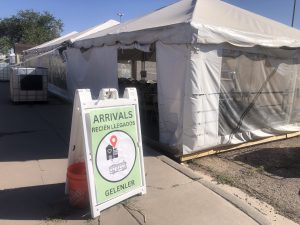
After I parked my car, Chuy escorted me past the tents and to the building entrance where Ben, Border Servant Corp’s travel director was waiting. Ben’s greeting is as warm as Chuy’s, as if we were also old friends. Ben introduces me to a couple more staff members, bilingual Latinas that are referred to as experts in helping migrants continuing their journey here in the States. These women provide all the information the migrants need from the moment they arrive to the moment they leave the facility, a former U.S. Army Reserve Center resembling a small school.
Once Border Patrol delivers a bus full of migrants to the center, they deboard the bus next to the white tents where they are given a bottle of water, an optional face mask and a plastic bag to carry what little possessions they have left. Once seated inside the tents, the migrants are given a verbal welcome and brief orientation in the tents before they are instructed to enter the building. Their first stop is a large room where migrants get one-on-one assistance in making domestic travel arrangements. A banner hangs across the wall that can’t be missed that says “BIENVENIDOS” in large letters.
Each of the migrants have a sheet of paper with their photo and information as proof that they have been vetted and registered by a border patrol agent. They are given a large manila envelope to protect this piece of paper. The envelope also serves as a traveling tool with the words “This is my first time traveling on a bus/airplane. Could you please help me find my next gate? Thank you,” in English and Spanish on the cover.
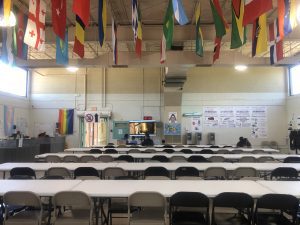 From this point, they wait till it is time to travel. Most remain at the shelter less than 24 hours. Information about bus, plane and shuttle services and their current location are available throughout the building. The waiting area is a cafeteria where sandwiches and snacks are made available at scheduled times each day. Phone charging and water bottle filling stations are also available to refill the water bottles.
From this point, they wait till it is time to travel. Most remain at the shelter less than 24 hours. Information about bus, plane and shuttle services and their current location are available throughout the building. The waiting area is a cafeteria where sandwiches and snacks are made available at scheduled times each day. Phone charging and water bottle filling stations are also available to refill the water bottles.
I was taken to meet BSC’s executive director, Kari and their director of operations, Kyle. I am introduced as Chuy’s old friend, an advocate for immigrants and journalist from Florida in that order. The five of us are seated around an office table. Chuy is seated next to me while Kari explains the history of the shelter, how it originated in 1997 and flourished as a church ministry of a local Evangelical Lutheran Church (ELCA). Its service area now includes neighboring El Paso, Texas. and Ciudad Juarez in Chihuahua.
Kari explained how BSC is now part of a large unofficial network of border shelters throughout the Southwest. The organization encourage groups to participate in their accompanied immersion program to better understand the borderlands and issues as they pertain to immigration. Groups in this program are given an opportunity to see firsthand how the system works. Participants are even taken to the border to experience Border Patrol operations as they process newly arrived migrants at the port of entry.
My mind filled with comments I commonly hear or read from people that oppose allowing asylum seekers enter the U.S. through the southern border. I asked the BSC team what they say to people that never experience welcoming immigrants to the US or perhaps want to see the border closed. Chuy replied without hesitation, “Everyone deserves a chance in this world.”
Chuy later expanded on his sentiment in a private correspondence. I asked him what motivates him to do this work every day.
“I do this work cause it gives me a true sense of satisfaction personal wise. I see in their faces; I hear their stories of the suffering they went through to get here to the United States. I served in the military for about 18 years, and I believed our purpose is to defend our greatest right freedom and democracy,” Chuy wrote. “I believe in helping the asylum seekers cause I believe it is the right thing to do. And besides,” Chuy added, “This country is made from immigrants from all over the world.”
My final visit for the day was with Micaela, BSC’s engagement and education director. Her graceful yet confident description of the organization’s outreach programs melded with my own experience and conclusion, “You just have to see it for yourself.”
Her words reaffirmed all that I ever knew about kindness and compassion for immigrants and even border patrol agents but had been shaken up by political rhetoric about immigration that most people have heard. It was at that moment that my phone began to light up with messages that the Florida governor had signed into law the new state immigration law, and my community in the Florida Panhandle was beginning to panic. I had to end my visit at the shelter for the day and begin answering messages.





